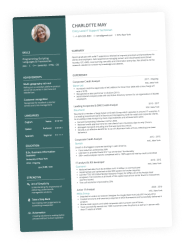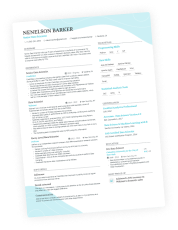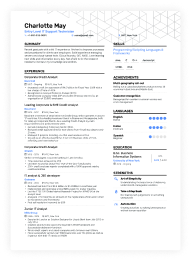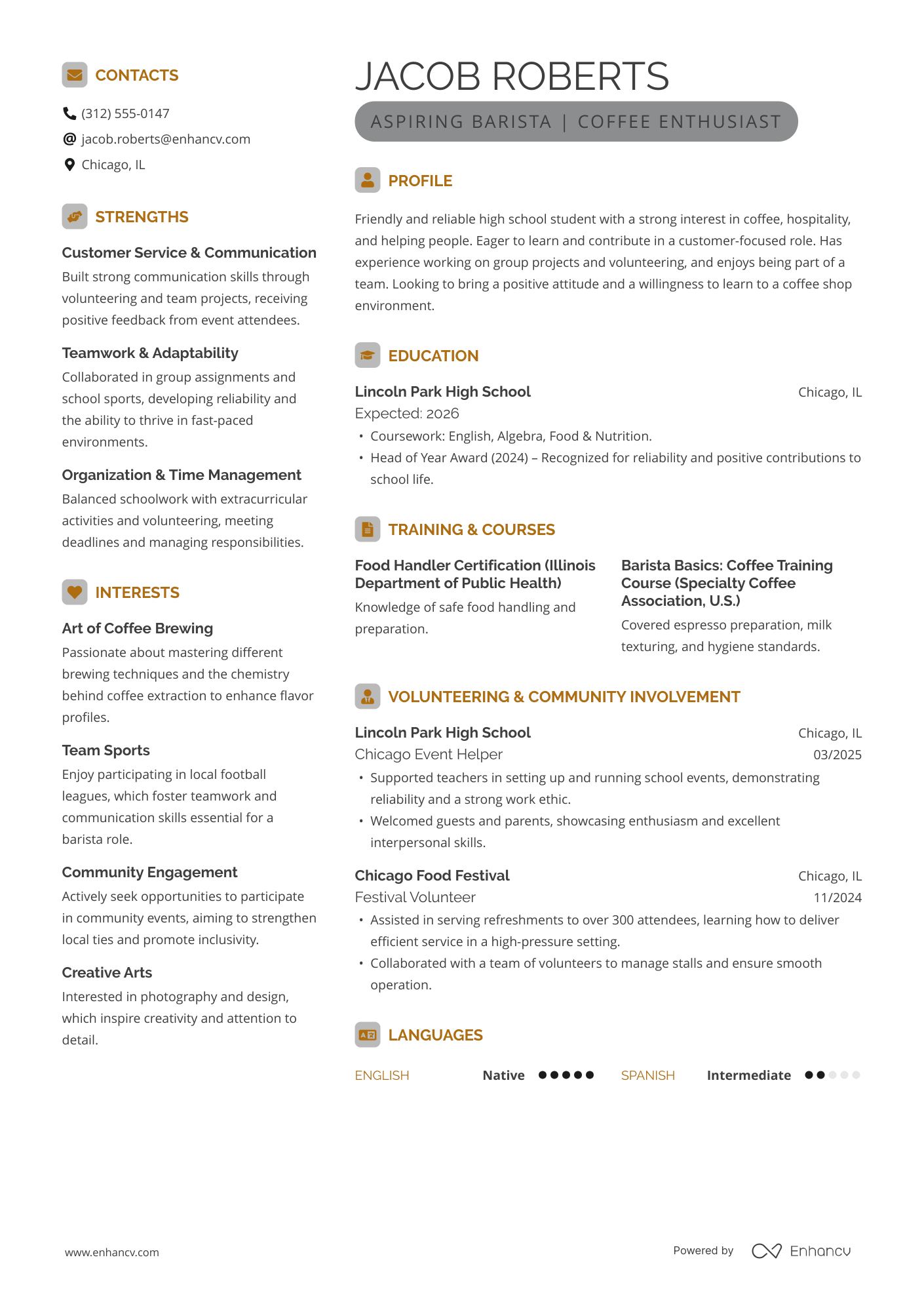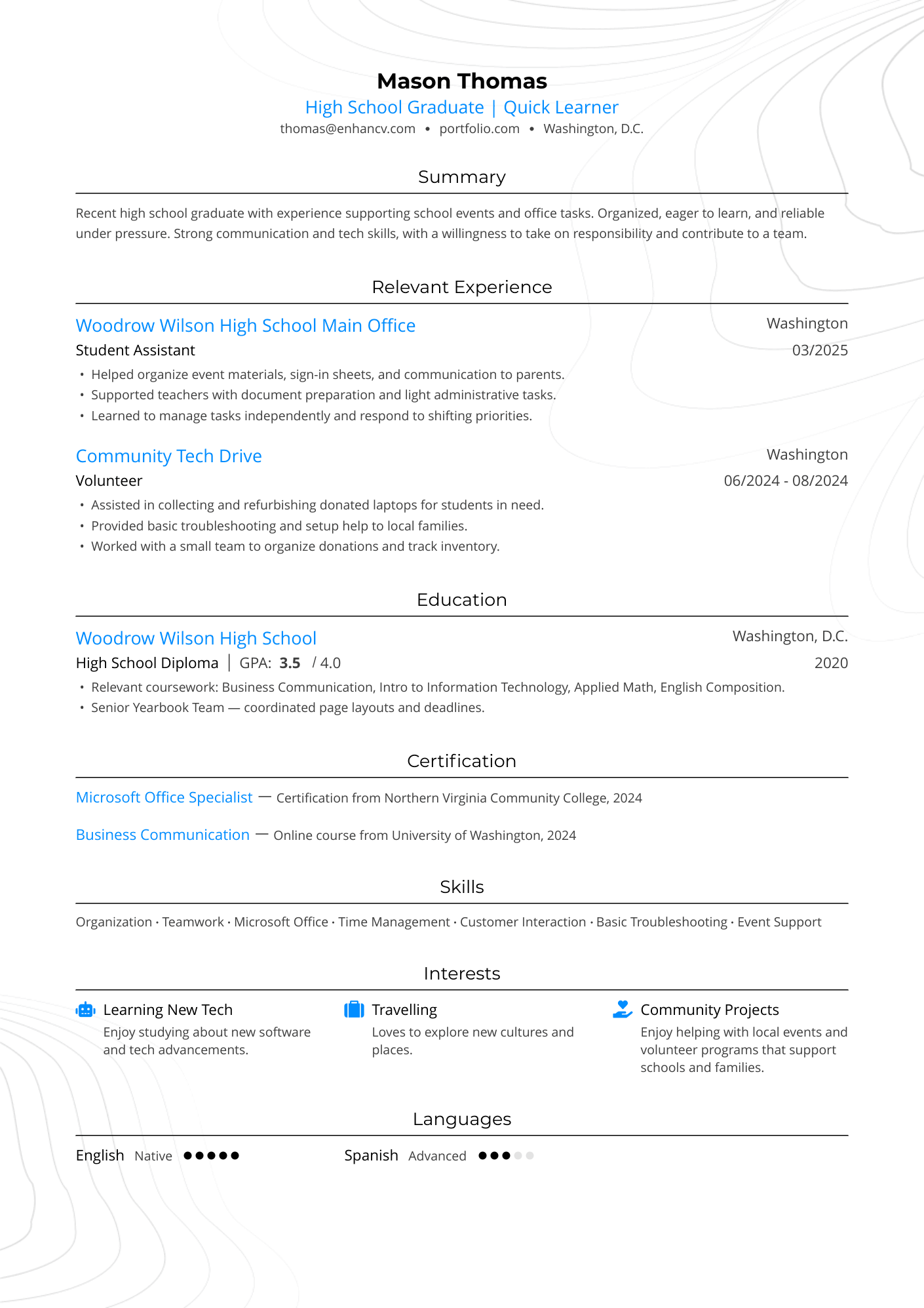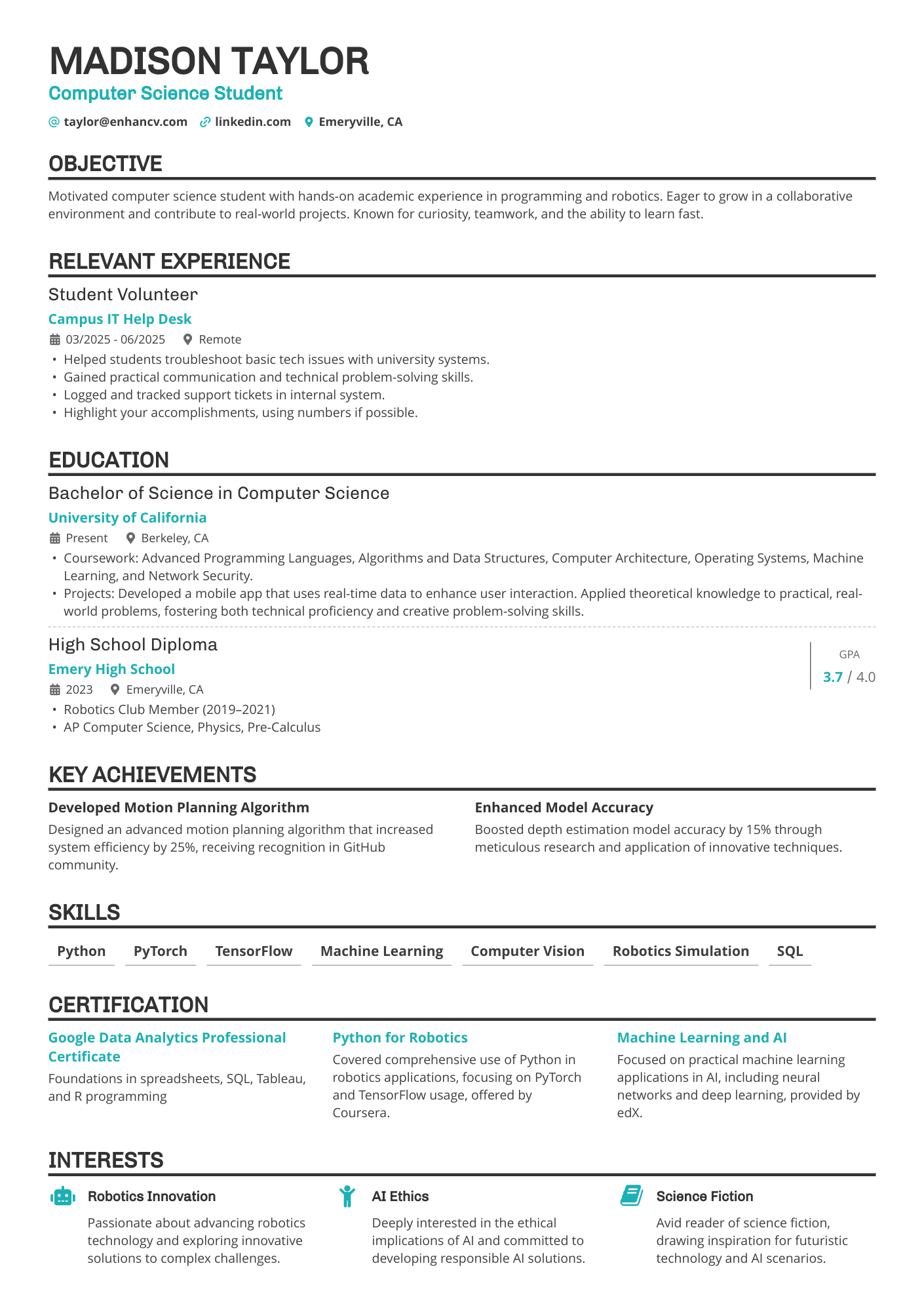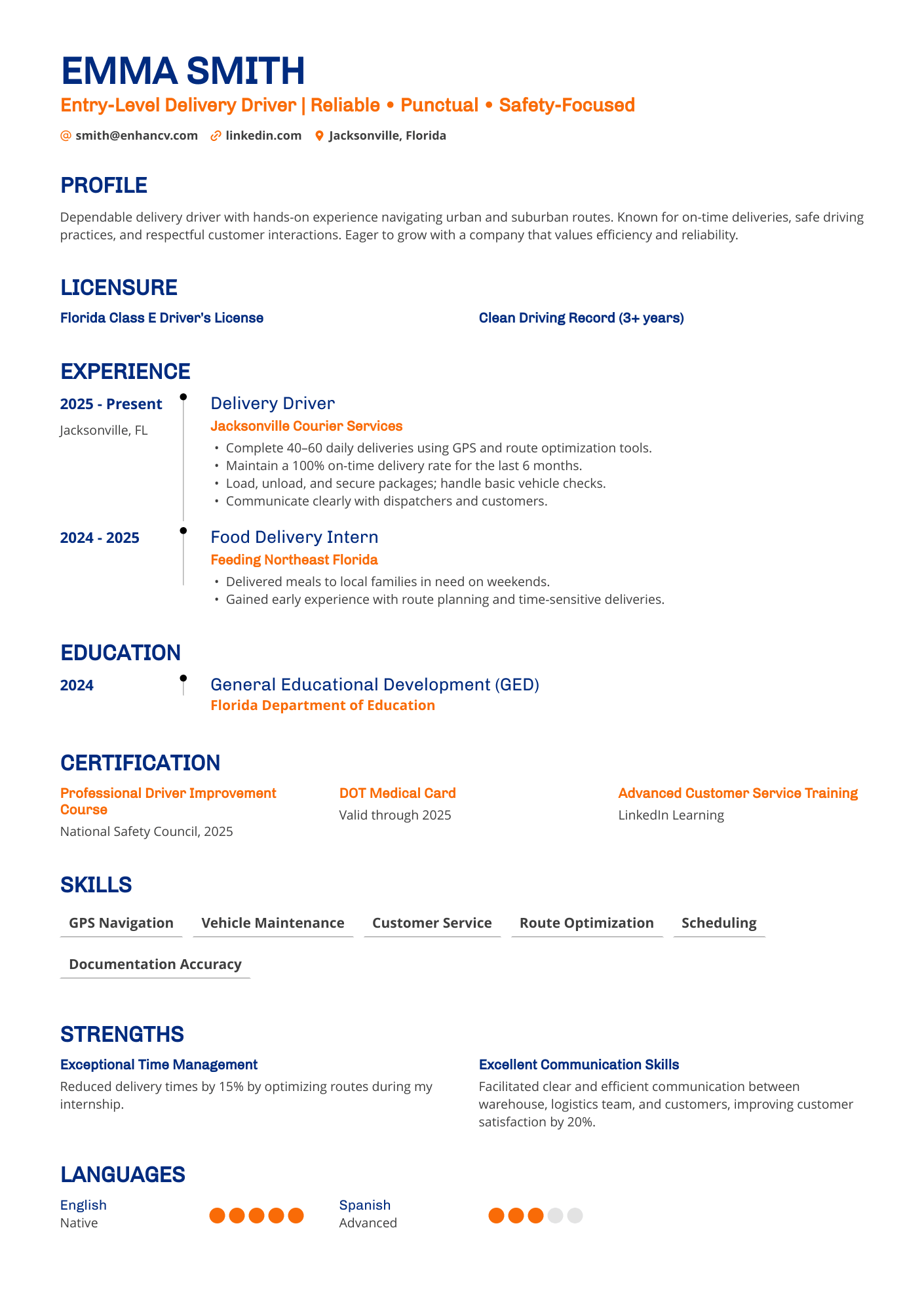Should you still include high school on your resume? It’s one of those questions that shouldn’t be hard, but somehow always is. Maybe you’re a recent grad, maybe you’ve got a few jobs under your belt—and now you're wondering if that old diploma still matters.
The answer depends on a few things: your experience, what you’re applying for, and how much that space on your resume is worth.
In this guide, we’ll break down exactly when to include high school, when to leave it off, how to format it, and real examples to make it easy.
Key takeaways
- Include high school if it’s your highest completed education or the only credential you have.
- Drop it once you’ve earned a college degree or built enough relevant work experience.
- Use keywords like “high school diploma”, “GPA”, and “relevant coursework” to stay ATS-friendly.
- Don’t list high school just because—make sure it adds value to your resume.
- Keep the format clean, consistent, and professional, especially if high school is doing the heavy lifting.
- For international education systems, add a quick note to localize your credentials.
Already have a resume? Run it through our free Resume Checkerto see if there are areas for improvements.
Is your resume good enough?
Drop your resume here or choose a file. PDF & DOCX only. Max 2MB file size.
What “high school” means in resume context
Let’s get something out of the way: when we talk about “high school” on a resume, we’re not just referring to the building you spent your teenage years in. We're talking about your highest level of formal education—if that's where your education stops, or if it’s still the most relevant.
That could mean a traditional diploma, a GED, or a regional equivalent. (For international readers, it might be A-levels, the IB program, or vocational secondary school.)
On a resume, “high school” isn’t about nostalgia—it’s about context. It fills a gap when there’s nothing else, or when it’s all you’ve got.
Key factors to decide if you should include your high school
Adding high school education to your resume isn’t a yes-or-no rule. It depends on what else you’ve got.
Below, we walk through exactly when it makes sense to keep high school on your resume, and when it’s probably time to let it go.
You should put high school on your resume if:
- You’re a current high school student or recent graduate: If you're still in school or just finished, high school is your main credential, and it’s completely expected to list it. Your high school diploma is how you meet employers’ basic education requirements.
- You have little or no work experience: Early in your career, hiring managers aren’t expecting a packed resume. What they’re looking for is potential, consistency, and effort. Including your high school education helps fill that gap, especially when paired with extracurriculars, volunteer work, or relevant coursework.
- Your high school achievements are worth showcasing: If you graduated with honors, had a strong GPA, or were involved in clubs, sports, or leadership roles—that’s valuable.
- The role specifically requires a high school diploma: This happens more than you might expect, especially in industries like retail, security, healthcare support, trades, and logistics. Sometimes a job posting will say “high school diploma required.” If that’s the case, list it clearly.
But there’s a line. And once you’ve crossed it, leaving high school off your resume is the smarter move.
You shouldn’t add high school to your resume if:
- You’ve completed a college degree (or higher): Once you’ve earned a college degree, your high school diploma becomes redundant. Employers are more interested in your most recent education.
- You have strong work or professional experience: If your resume already includes relevant roles, internships, or certifications, listing high school can feel like backtracking. Use the space for something more current, especially if you’re tight on page length.
- Your high school experience doesn’t add much to the story: Maybe you were homeschooled, followed an alternative curriculum, or simply don’t feel those years reflect who you are now. If it doesn’t strengthen your resume or support the role you’re applying for, it’s perfectly okay to leave it off.
Do homeschool credentials count as “high school” for resumes?
Yes. A completed homeschool program is considered a valid form of high school education. In fact, about 6% of U.S. students are homeschooled and studies show they often score 15–25% higher than public school peers on standardized tests.
Whether your high school experience comes from a traditional path or a homeschool program, if you’ve decided it belongs on your resume, the next step is getting it right.
Here’s how to write it clearly and professionally.
How to list high school on a resume (if it belongs there)
Once you’ve decided to include high school, the next step is placing it properly—inside your education section. That’s where it should be, whether it’s your only academic credential or just part of the picture.
From there, it’s about showing it clearly and keeping it relevant.
What to include:
- School name: Full name, no abbreviations.
- Location: City and state (don’t include full addresses).
- Graduation year: If you’re still enrolled, write “Expected [Year]”.
- GPA: Only if it’s strong (generally 3.5 or higher) and recent.
- Relevant coursework or subjects: Optional, but useful if it ties into the job.
- GED: If you earned a GED instead of a diploma, list it like so: GED, [State or School Name, if applicable], [Year].
Look at a good example:
Central High School
Austin, TX | Graduated: 2023
- GPA: 3.8
- Relevant coursework: Intro to Computer Science, AP English
These are the baseline details for your high school education section. Now, let’s look at how to handle it if you're still in school or didn’t graduate.
How to write it if you didn’t graduate or if school is ongoing
You can still include your high school education—just be transparent.
Here’s how to frame your education entries:
If you’re still studying, format it like this:
Central High School
Austin, TX | Expected Graduation: 2026
If your high school education was incomplete, write:
Central High School
Austin, TX | Attended 2018–2021
You don’t need to justify why you didn’t finish if that’s your case. Just list the dates you attended or that you're currently studying. If asked in an interview, be prepared with a simple, non-defensive answer that moves the focus back to your skills or goals.
How to strengthen your high school resume entry
When high school is the only education you’re listing, you can give it more impact by adding a few details that show you’ve done more than just show up to class. These can give hiring managers a sense of how you communicate, organize, or take initiative.
Focus on what’s relevant to the role you’re targeting.
Here’s what you can include, followed by an example:
- Leadership roles (student council, club officer, team captain)
- Consistent volunteering (especially if it's public-facing or involves responsibility)
- Awards or honors (academic or personal initiative)
- Any roles where you organized, presented, or supported others
Riverside High School
Columbus, OH | Graduated: 2023
- GPA: 3.6
- Student Council Secretary — helped organize three school-wide events.
- Volunteer, Community Food Bank — assisted weekly intake and distribution (2022–2023).
Once you’ve decided what to include, don’t let formatting trip you up.
Here’s how to make sure your education section looks clean and does its job:
- Place your education section near the top if you don’t have much work experience. It should be one of the first things recruiters see.
- Keep formatting consistent—use the same font, spacing, and bullet style you’ve used throughout your resume.
- Use reverse-chronological order—list your most recent education first, even if that means your high school entry comes after some college or training.
- Skip the high school listing if your college degree is complete. In most cases, the higher credential is all that’s needed.
Simple details, but they make a big difference when someone’s scanning your resume in under 30 seconds.
A simple rule of thumb for putting high school on a resume
If high school is the highest level of education you've completed, it usually belongs on your resume.
If you've gone further and that experience tells a stronger story, you can leave it off.
Resume examples that show when and where to include high school
Here are a few complete resume samples, created by our team of Certified Professional Résumé Writers. You can easily personalize them using Enhancv’s AI Resume Builder. Each example highlights a different education stage and shows exactly how—and when—high school belongs on a resume.
Still in high school
If you’re a student applying to part-time jobs, internships, or first-time roles, high school must be added. It’s your only formal credential after all.
This resume shows how to make the most of the education section when you’re just starting out. Relevant coursework like Food & Nutrition hints at industry interest, while the Head of Year Award adds credibility by showing the person’s involvement and reliability within the school community.
Recent high school graduate (no college yet)
This example is for job seekers who’ve recently finished high school but haven’t started college–whether by choice, circumstance, or simply needing to work first.
The education section sits further down the page, since the candidate already has some experience—but it’s still used strategically, with GPA and relevant coursework helping to fill in the gaps and show potential.
Entry-level job seeker with some college (but no degree yet)
You’re in college—or maybe you started but didn’t finish—and now you’re unsure whether high school still belongs on your resume. Should you list both, or drop high school the moment college enters the picture?
At the entry level, it’s still worth showcasing everything that adds value. This example does just that.
GED holder
Not everyone follows the traditional high school-to-college path and that’s perfectly okay. This example shows how a candidate with a GED and hands-on delivery experience can build a focused, job-ready resume.
The education section is short but direct, while the experience and certifications do the heavy lifting to highlight dependability, safety, and customer service.
With Enhancv’s resume templates, you can create an application that’s clear, concise, and fully readable by both ATS systems and human hiring managers, no formatting guesswork required.
Should you optimize your resume for ATS when listing high school?
If you're listing high school on your resume—whether it’s a diploma, GED, or coursework—it's important that applicant tracking systems (ATS) can read and understand that information.
Make sure you use terms that match what employers are looking for. These help your resume pass through automated filters, especially when education is a key requirement.
Here’s what you need to know:
- “High school diploma”: Even if it's obvious, many ATS tools are scanning for this exact phrase.
- “GED” or “General Educational Development”: If applicable, don’t just list the year —include the full term.
- “Expected graduation: [Year]”: Signals ongoing education clearly.
- “Relevant coursework”: Adds keyword context when experience is limited.
- “GPA”, “honors”, “AP courses”, “extracurriculars”: When included appropriately, these can help round out the section and show academic involvement.
Avoid vague phrasing like “completed school” or “basic education.” They’re less recognizable to both ATS systems and hiring managers.
To better match your resume to the skills and keywords employers are looking for, try Enhancv’s AI Resume Tailoring— it helps you align your content with job descriptions and pass ATS scans with confidence.
Frequently asked questions on featuring high school on resumes
Still have questions about when high school belongs on your resume, or how to list it in less straightforward situations?
Here are a few quick answers that cover common edge cases.
I went to college but didn’t finish—do I include high school?
Yes. If you didn’t complete your college degree, your high school diploma is still your highest completed education and it should be listed. You can include both entries, but be clear about your college status (e.g., “Completed coursework toward B.A. in Psychology”).
My GPA in high school was low—should I still put it?
No. If your GPA is below 3.5, it’s better to leave it out. GPA is always optional, and it should only be added if it strengthens your application.
I’m many years out of school—does it still matter?
In most cases, no. If you’ve built enough work experience, especially in the past five to ten years, your education becomes less relevant. At that point, listing a high school diploma is optional and often unnecessary.
What if I have international high school credentials (IB, A-levels, HSC, etc.)?
You should list your qualifications clearly, and add a short note to help U.S. employers or ATS systems understand the level. Don't assume familiarity with international systems—localizing your credentials makes your resume more readable and relevant.
Here’s how you might format it:
- A-levels (UK), Completed 2022 — Equivalent to U.S. high school diploma
Subjects: Physics, Chemistry, Mathematics - Higher School Certificate (HSC), NSW, Australia, 2021 — Comparable to U.S. high school completion
- International Baccalaureate (IB) Diploma, 2023 — Globally recognized high school finequivalent
This approach helps ensure ATS software picks up on the right keywords (like “high school diploma”), while also providing clarity for hiring managers unfamiliar with your education system.
If you’re applying outside your home country, it’s worth checking what local employers expect. You can find detailed advice in our U.S. Resume Guide, Canadian Resume Guide, and International Resume Guide to help tailor your format and phrasing to the region you're targeting.
Should I list high school courses if relevant to the job?
Yes, but only if they directly support the role. If not, skip them and focus on broader skills or experiences.
Conclusion
Listing high school on your resume might seem like a small detail, but when you’re early in your career or your education path isn’t linear, that detail can make a difference. Whether you’re still in school, finished recently, or navigating a less traditional path, the goal is the same: show employers how it supports where you’re going next.
Use your high school education entry to fill in the blanks, build credibility, and show initiative, but don’t let it overstay its welcome. Once you’ve got more recent accomplishments, let them take the spotlight.
Make one that's truly you.

